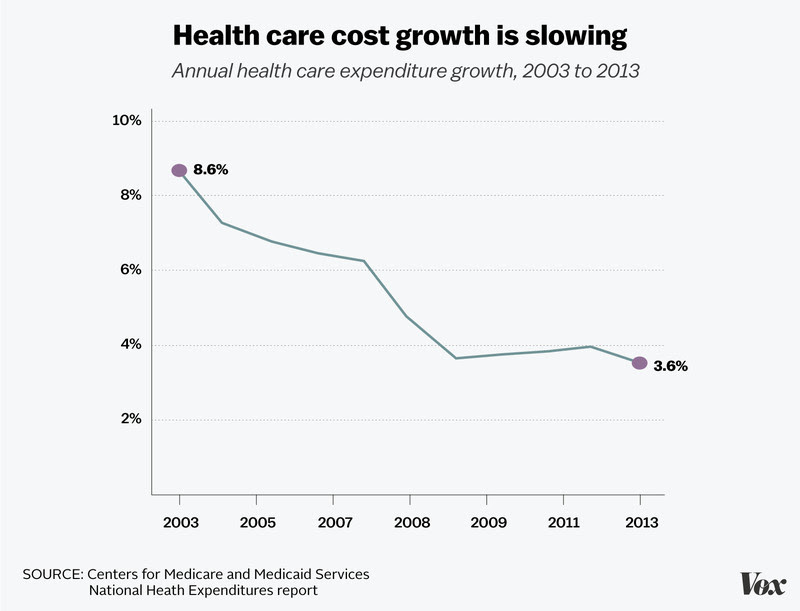
The architects of the Affordable Care Act got millions of Americans to sign up for coverage. Now they're quietly crafting the next Democratic health-care agenda: lowering costs.
A half-dozen key Democratic policy influencers, from the head of Hillary Clinton's 2008 policy team to former Obama administration officials, are starting to plan for a post-Obamacare Washington. In recent interviews, they describe twin goals — improving quality of care while making it cheaper — that will require building a coalition quite different from the one that supported health reform in 2010.
"The ACA is here to stay and we should assume that, but that doesn't mean everyone is satisfied," says Center for American Progress president Neera Tanden, who has close ties to Hillary Clinton after running her policy staff in 2008. "Health expenditures are a big problem from the individual perspective. If you look at public opinion and what people are most anxious about, it's still health care costs."
"THE ACA IS HERE TO STAY, BUT THAT DOESN'T MEAN EVERYONE IS SATISFIED"
Obamacare faced ferocious opposition from the right, but the underlying idea — get more people signed up for coverage — was one that public health advocates and liberals could rally behind. Now, as the priority shifts to quality and cost, the policy problems become much more difficult to tackle and the solutions less clear.
Policies that reduce cost systemwide often leave consumers paying more out-of-pocket for health care. That can split coalitions that came together around the more unifying goal of covering the uninsured.
"We're trying to get groups that represent consumer-type constituencies to begin a much more significant focus on quality and cost," says Ron Pollack, president of the non-profit Families USA, a group that was instrumental in organizing advocates and industry in support of the Affordable Care Act.
THE POLICY PROBLEMS WILL BECOME MORE DIFFICULT — AND SOLUTIONS LESS CLEAR
Building coalitions in the multi-billion health-care industry, where each stakeholder has different priorities, is excruciating work. A litany of failed attempts at health reform (including Hillary Clinton's own 1994 efforts) provide a gloomy backdrop. So some are skeptical that, after the Obamacare battle left many badly bruised, health care will become a prominent agenda item on the next Democratic president's docket.
"They will do everything they can to not use the phrase health care, Obamacare, Medicare, period," says Bob Kocher, a former Obama administration official. "The standard talking points will be that we're proud we expanded coverage to all Americans and that we want to protect that."
Why Democrats care about cost
There are myriad thorny health policy issues that Democrats could tackle, everything from getting coverage to the millions of Americans still uninsured to reforming medical malpractice laws. But the increasing consensus is that the next effort will have to focus on reducing costs for one simple reason. Health care in the United States is expensive. Insanely, outlandishly expensive.
The United States spends $2.8 trillion on healthcare annually. That works out to about one-sixth of the total economy and more than $8,500 per person — and way more than any other country. The average American spends $735 annually on out-of-pocket health care costs (which is spending above and beyond monthly premiums).
The past five years have brought a glimmer of good news: health-care costs have grown at a slower pace. After years of rising faster than the economy, health spending has grown at the same rate as other sectors since 2009.

But consumer advocates are concerned that the individuals aren't seeing enough of that slowdown show up in their wallets — that health insurers and hospitals, rather than consumers, have reaped most of the benefits.
Workers' contributions to their insurance benefits have increased 81 percent over the past decade, the Kaiser Family Foundation recently found. Employers' contributions rose too, but more slowly (65 percent).
The percent of workers in a plan with a deductible over $1,000 has risen from 6 percent in 2006 to 32 percent in 2014, the same study showed.
This is the paradox of cost control in the health-care system: so much of the spending is hidden from patients, and so many of the cost-control efforts rely on making that spending more visible to patients, that successful efforts to cut costs can feel to patients like cost increases.
"We want to ensure that the benefits of slower cost growth actually drive towards individuals," Tanden says. "They're the only people who aren't benefiting right now."
Health care's "strange bedfellows" coalitions will get rearranged

"We're trying to get groups that represent consumer-type constituencies to begin a much more significant focus on quality and cost," says Families USA president Ron Pollack, pictured here sharing the stage with President Barack Obama at a 2011 conference. (Tim Sloan / AFP via Getty News Images)
Just like Obamacare, the battle to lower costs will require new coalition building, and risks turning one-time friends into enemies. The doctors and hospitals who benefit from expanded coverage — and a wave of new consumers — are the exact same constituencies that stand to lose the most if America spends less on medicine.
In the lead-up to the Affordable Care Act debate, Families USA organized a series of "strange bedfellows" meetings with health care groups across the political spectrum. This helped get everyone from unions to insurers to doctors onboard behind the concept of expanding coverage.
Four years later, in 2013, Pollack quietly worked on what he calls a "mini-version" of the same meetings. He held about a dozen meetings with Karen Ignagni, chief executive of America's Health Insurance Plans, and officials from the Pacific Business Group on Health, which represents employers.
"Some of these groups aren't necessarily the ones who were our strongest allies on the Affordable Care Act," Pollack says. Insurers were a bit leery of the health reform effort, which would force them to accept the very sick customers that their individual market plans typically rejected.
"THE BEDFELLOWS GET RE-ARRANGED DEPENDING ON WHAT IS GOING ON"
But in this new round of reform, insurers arguably stand to be one of the biggest winners. They benefit if costs go down because they can sell less expensive coverage — and that makes them the more natural partner of Democrats in this new era of reform.
"This is an issue where the bedfellows get re-arranged depending on what is going on," says Zeke Emanuel, a senior fellow at the Center for American Progress and former Obama advisor on health policy. "Doctors and hospitals are a big part of the area where we have to reduce costs. They may not be so friendly to every industry on that score."
The hospitals who embraced Obamacare quickly may approach this new effort skeptically: cuts to overall health spending could translate into cuts to their bottom lines.
Democrats start to get specific on Obamacare 2.0

Neera Tanden hugs Hillary Clinton at a Center for American Progress 10th anniversary event. (Chip Somodevilla/Getty News Images)
Exactly how to control health care costs will be a matter of debate among policy experts over coming months, but some ideas are already beginning to emerge in advance of the 2016 election.
Families USA outlined its priorities in a January 2015 paper tiled "Health Reform 2.0," which included ideas like giving public programs the authority to negotiate lower drug prices and putting lower caps on deductibles in Obamacare plans.
IDEAS RANGE FROM LOWER DRUG PRICES TO CAPPING DEDUCTIBLES
Tandeen says CAP will release a similar paper later this year, though she declined to comment on particular policy approaches until then. But there is a paper that Tandeen and many other CAP fellows co-authored in the New England Journal of Medicine in 2012, which gives some clues about their current thinking.
The list of 23 authors on the paper, titled "A Systemic Approach to Containing Health Care Spending," reads like a who's who of the Democratic health policy establishment. At least half have spent time in the Obama administration. It suggests full transparency on health care prices, allowing the government to competitively bid for the medical equipment it buys Medicare patients, and increasing the scope-of-practice for lower-level providers like nurse practitioners.
THE BIG GOAL: LOWER COSTS WITHOUT HURTING CONSUMERS
"To effectively contain costs," they write, "solutions must target the drivers of both the level of costs and the growth in costs. Solutions will need to reduce costs not only for public payers but also private payers. Finally, solutions will need to root out administrative costs that do not improve health status."
Papers like this come out all the time in Washington. But one with so many CAP co-authors is especially important because of the think tank's close ties to Hillaryland. Its founder, John Podesta, has already been announced as the chair of her not-yet-existent campaign. And Tanden was policy director for Clinton's 2008 campaign.
Most groups, CAP included, are also enthusiastic about proposals that would tether more health care dollars to the quality of care that patients receive — an idea the Obama administration has taken up in recent months. In January, Health and Human Services set a goal of having at least 90 percent of all Medicare payments related to quality by 2018.
A new Democratic administration would likely take leadership on how to make sure hospitals and doctors actually hit that benchmark.
Will the next White House make health care a priority?

President Obama signs the Affordable Care Act in 2010 (Win McNamee / Getty News Images)
How quickly Democrats could — or would – move on health care remains an area of debate. The president and Democratic legislators have had to spend five years now dealing with the fallout of passing a divisive law that has not become more popular since the day it passed.
But others argue that health care is an inevitable agenda item for any president, Democratic or Republican. The fact that health care costs consume one-sixth of the American economy makes them a huge budgeting concern — whether a president is enthusiastic about the inevitable political battles or not.
"There is sometimes a Washington perspective that 'the Democrats did health care,'" Emanuel says. "You don't 'do' health care once. You do health care forever. It's not a marathon. It's life."
Read more: http://www.vox.com/2015/2/23/8082769/obamacare-democrats-priorities

